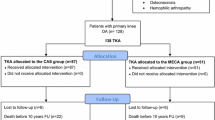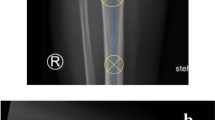Abstract
Purpose
To compare the clinical outcomes and survival at long-term between hybrid and cemented primary total knee arthroplasty (TKA). A better clinical outcome and survival following a follow-up as long as 15 years with the use of hybrid fixation as compared with cemented fixation was hypothesized.
Methods
Case–control study of 126 patients with a mean age of 62.4 years who underwent hybrid TKA matched with 126 patients underwent cemented TKA. Clinical outcome was assessed by the Knee Society scores (KSS) and reduced Western Ontario and MacMaster Universities questionnaire (WOMAC). Radiological assessment was made by the Knee Society method.
Results
The mean follow-up was 15.7 (range 15–17) years. At the final follow-up, clinical scores were significantly better in the hybrid group, although the differences were not clinically relevant. Revisions for all reasons were performed in five knees in the hybrid group and 15 knees in the cemented group (p = 0.033). In the hybrid group, there was one aseptic femoral loosening and no aseptic tibial loosening. In the cemented group, the main reasons for aseptic revisions were polyethylene wear (six knees) and tibial loosening (four knees). Cemented fixation was a significant risk factor for aseptic revision (hazard ratio 2.3; 95% CI 1.3–3.7%; p = 0.004). Survival at 15 years for aseptic reasons was 96.5% (95% CI 93.4–98.7%) in hybrid groups and 90.3% (95% CI 88.7–93.9%) in cemented group (p = 0.020).
Conclusion
After a minimum follow-up of 15 years, hybrid fixation of primary TKA for osteoarthritis provide significantly higher clinical benefits compared with cemented fixation, but the differences were not clinically relevant. Hybrid fixation provides longer overall survival, although the femoral component survival was similar between groups.
Level of evidence
III.
Similar content being viewed by others
References
Ang JE, Bin Abd Razak HR, Howe TS, Tay BK, Yeo SJ (2017) Obesity does not affect outcomes in hybrid versus cemented total knee arthroplasty in Asians. J Arthroplast 32:3643–3646
Bellamy N, Buchanan W, Goldsmith CH, Campbell J, Stitt LW (1988) Validation study of WOMAC: a health status instrument for measuring clinically important patient relevant outcomes to antirheumatic drug therapy in patients with osteoarthritis of the hip and the knee. J Rheumatol 15:1833–1840
Berger RA, Lyon JH, Jacobs JJ, Barden RM, Berkson EM, Sheinkop MB, Rosenberg AG, Galante JO (2001) Problems with cementless total knee arthroplasty at 11 years follow-up. Clin Orthop Relat Res 392:196–207
Campbell MD, Duffy GP, Trousdale RT (1998) Femoral component failure in hybrid total knee arthroplasty. Clin Orthop Relat Res 356:58–65
Carr AJ, Robertsson O, Graves S, Price AJ, Arden NK, Judge A, Beard DJ (2012) Knee replacement. Lancet 379:1331–1340
Charlson M, Szatrowski TP, Peterson J, Gold J (1994) Validation of a combined comorbidity index. J Clin Epidemiol 47:1245–1251
Choi YJ, Lee KW, Kim CH, Ahn HS, Hwang JK, Kang JH, Han HD, Cho WJ, Park JS (2012) Long-term results of hybrid total knee arthroplasty: minimum 10-years follow-up. Knee Surg Relat Res 24:79–84
Collados-Maestre I, Lizaur-Utrilla A, GonzalezNavarro B, Miralles-Munoz FA, Marco-Gomez L, Lopez-Prats FA, Gil-Guillen V (2017) Better functional outcome after single-radius TKA compared with multi-radius TKA. Knee Surg Sports Traumatol Arthrosc 25:3508–3514
Demey G, Servien E, Lustig S, Aït Si Selmi T, Neyret P (2011) Cemented versus uncemented femoral components in total knee arthroplasty. Knee Surg Sports Traumatol Arthrosc 19:1053–1059
Duffy GP, Murray BE, Trousdale RR (2007) Hybrid total knee arthroplasty analysis of component failures at an average of 15 years. J Arthroplast 22:1112–1115
Escobar A, Quintana JM, Bilbao A, Aróstegui I, Lafuente I, Vidaurreta I (2005) Responsiveness and clinically important differences for the WOMAC and SF-36 after total knee replacement. Osteoarthr Cartil 13:1076–1083
Ewald FC (1989) The Knee Society total knee arthroplasty roentgenographic evaluation and scoring system. Clin Orthop Relat Res 248:9–12
Faris PM, Keating EM, Farris A, Meding JB, Ritter MA (2008) Hybrid total knee arthroplasty: 13-year survivorship of AGC total knee systems with average 7 years follow-up. Clin Orthop Relat Res 466:1204–1209
Gao F, Henricson A, Nilsson KG (2009) Cemented versus uncemented fixation of the femoral component of the NexGen CR total knee replacement in patients younger than 60 years: a prospective randomised controlled RSA study. Knee 16:200–206
Henricson A, Wojtowicz R, Nilsson KG, Crnalic S (2019) Uncemented or cemented femoral components work equally well in total knee arthroplasty. Knee Surg Sports Traumatol Arthrosc 27:1251–1258
Illgen R, Tueting J, Enright T, Schreibman K, McBeath A, Heiner J (2004) Hybrid total knee arthroplasty: a retrospective analysis of clinical and radiographic outcomes at average 10 years follow-up. J Arthroplast 19(7 2):95–100
Insall JN, Dorr LD, Scott RD, Scott WN (1989) Rationale of the Knee Society clinical rating system. Clin Orthop Relat Res 248:13–14
Kobs JK, Lachiewicz PF (1993) Hybrid total knee arthroplasty: two- to five-year results using the Miller-Galante prosthesis. Clin Orthop Relat Res 286:78–87
König A, Kirschner S, Walther M, Eisert M, Eulert J (1998) Hybrid total knee arthroplasty. Arch Orthop Trauma Surg 118:66–69
Kuriyama S, Hyakuna K, Inoue S, Kawai Y, Tamaki Y, Ito H, Matsuda S (2018) Bone-femoral component interface gap after sagittal mechanical axis alignment is filled with new bone after cementless total knee arthroplasty. Knee Surg Sports Traumatol Arthrosc 26:1478–1484
Lizaur-Utrilla A, Gonzalez-Parreño S, Martinez-Mendez D, Miralles-Muñoz FA, Lopez-Prats FA (2019) Minimal clinically important differences and substantial clinical benefits for Knee Society scores. Knee Surg Sports Traumatol Arthrosc. https://doi.org/10.1007/s00167-019-05543-x
McLaughlin JR, Lee KR (2014) Hybrid total knee arthroplasty: 10- to 16-year follow-up. Orthopedics 37:975–977
Nakama GY, Peccin MS, Almeida GJ, Neto OD, Queiroz AA, Navarro RD (2012) Cemented, cementless or hybrid fixation options in total knee arthroplasty for osteoarthritis and other non-traumatic diseases. Cochrane Database Syst Rev 10:CD006193
Noble PC, Conditt MA, Thompson MT, Stein JA, Kreuzer S, Parsley BS, Mathis KB (2003) Extraarticular abrasive wear in cemented and cementless total knee arthroplasty. Clin Orthop Relat Res 416:120–128
Pelt CE, Gililland JM, Doble J, Stronach BM, Peters CL (2013) Hybrid total knee arthroplasty revisited: midterm follow-up of hybrid versus cemented fixation in total knee arthroplasty. Biomed Res Int 2013:854871
Perry CR, Perry KI (2016) Femoral component survival in hybrid total knee arthroplasty. Orthopedics 39:181–186
Petursson G, Fenstad AM, Havelin LI, Gøthesen Ø, Lygre SH, Röhrl SM, Furnes O (2015) Better survival of hybrid total knee arthroplasty compared to cemented arthroplasty. Acta Orthop 86:714–720
Ritter MA (2009) The anatomical graduated component total knee replacement: a long-term evaluation with a 20-year survival analysis. J Bone Joint Surg Br 91:745–749
Rorabeck CH (1999) Total knee replacement: should it be cemented or hybrid? Can J Surg 42:21–26
Vertullo CJ, Graves SE, Peng Y, Lewis PL (2018) The effect of surgeon’s preference for hybrid or cemented fixation on the long-term survivorship of total knee replacement. Acta Orthop 89:329–335
Wang Z, Chen X, Zhou Y, Shao H, Huang Y, Deng W (2020) Hybrid fixation versus full-cemented or full-cementless fixation in total knee arthroplasty: systematic review and meta-analysis of comparative studies. J Orthop Sci. https://doi.org/10.1016/j.jos.2019.12.009
Yang JH, Yoon JR, Oh CH, Kim TS (2012) Hybrid component fixation in total knee arthroplasty: minimum of 10-year follow-up study. J Arthroplast 27:1111–1118
Funding
There is no funding source.
Author information
Authors and Affiliations
Corresponding author
Ethics declarations
Conflict of interest
The authors declare that they have no conflict of interest.
Ethical approval
This study was approved by the Institutional Review Board of Elda University Hospital (Miguel Hernandez University), ID number PI2019-021.
Informed consent
Informed consent was obtained from all individual participants included in the study.
Additional information
Publisher's Note
Springer Nature remains neutral with regard to jurisdictional claims in published maps and institutional affiliations.
Rights and permissions
About this article
Cite this article
Lizaur-Utrilla, A., Miralles-Muñoz, F.A., Ruiz-Lozano, M. et al. Better clinical outcomes and overall higher survival with hybrid versus cemented primary total knee arthroplasty: a minimum 15 years follow-up. Knee Surg Sports Traumatol Arthrosc 29, 832–837 (2021). https://doi.org/10.1007/s00167-020-06028-y
Received:
Accepted:
Published:
Issue Date:
DOI: https://doi.org/10.1007/s00167-020-06028-y




